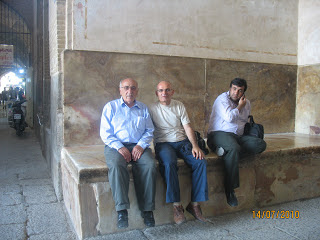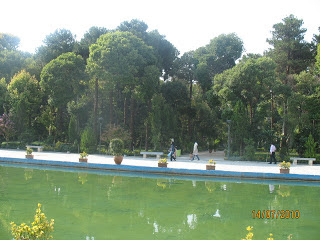ESFAHAN 14.07.2010
ESFAHAN 14.07.2010
The train departed from station at
22:50. Including me, we were six altogether in one compartment.
I do not remember any of them. They didn't speak Turkish; I
didn't speak English. I preferred to sleep early. These guys
were yelling to me, "Hey, Mister!" speaking from
downstairs while I was lying over the bunk . I didn’t mind them. I had slept
until morning. The train arrived to Esfahan station early in the morning.
I saw the first fresh lights of the sun under blue sky which was amazing.
The weather was quite dry and fresh.
As is usual everywhere, the taxi drivers
were waiting to take a couple of passengers going to city center. I
waited for the public bus like the majority of the passengers. We all got off the bus together in Siosepol at the
Bridge of Esfahan entrance. I met Ali Parsa there, while I was
looking around asking for directions to Imam square. Ali said
that he had worked in Istanbul before. He was speaking good Turkish, I don’t
recall whether Ali was an Azerbaijani Turk or not.
Ali and I walked on the granite
sidewalk up to İmam square . With the first glance, you would
be able to understand that Esfahan deserved the famous rhymed sentence
about itself.
"Esfahan nısf -ı Cihan !"
"Esfahan , the half of the world!" If you haven’t
seen Esfahan , it means that you have not seen half of the world..
Tabriz people say about Esfahan that "if
you have not been to Tabriz".
Esfahan was a capital of The Great Seljuk
Turk state and Safavid State. Both of them Turkish states in
history. One has to remember that Ottoman and Safavid states fought
against each other many times.
Before we left, I took a photo
together with Ali in front of Square. Firstly, I should have left
my bag in the hotel. There was a recommendation for a hostel in the guide
book of Zafer Bozkaya. I found Amir Kabir Hostel in Cahr-Tagh ( four way
intersection) . The hostel is preferred by backpackers
. İt was a surprise to see Andre and Paul, my friends from the train
compartment there . They had come yet. We shared a
room which cost 8 dollars per night. There was a communal
bathroom outside the room. I had a breakfast in the hostel
which cost 2,5 dollars.
I went to İmam Square again early in
the morning only a few other people were there. There would be crowds in
the evening. The shops surrounding the square were closed at midday
for 3-4 hours due to the extreme heat. In the evening the shops were open
again.
We sat on the stone in front of Ali Qapu
Palace. İt was a little cooler there when compared to the open field.
I met with one middle age man named Hussein.
Hussein said he had been a lorry
driver before. He had not worked for a while. He tried to
communicate with me in a little bit of English. It was very interesting
and in spite of the language difficulty, we got to understand each other.
I mentioned to him about the Zourkhaneh rıtuals that I would
like to see and told him that I had not encountered this
traditional sport in Tabriz or Tehran. This sport is practised in a gymnasium
called Zourkhaneh. The Zoorkhanei ritual is a traditional Iranian
martial art. According to him these kinds of places for performing
the ritual were closed and there are just a few of them in İran. One
of them was in Esfahan. He proposed to me that if I would like to see it,
we could meet in that evening to go there. I was really glad to hear
that I would be able to see it. Hussein also added some information
regarding the visit. A payment of about 4-5 dollars was
required by each of us for the rhythm chef of Zoorkhaneh. I accepted
this suggestion as it was affordable. We left to meet again. We
would meet at 20:30 in the same place .
There was enough free time until we would
meet again. I went to visit Chehel Sotoun, a pavilion in the middle of a park
at the far end of a long pool, in Isfahan, Iran. It was built by Shah Abbas II
to be used for his entertainment and reception. İts name means
"Forty Columns" in Persian.
The water of pool was very green. I
understood that there was no cleaning system ,which resulted in some
bacteria growing due to the sunlight on the stagnant water.
I should mention its wooden columns.
You can see only twenty wooden columns at the entrance of the building.
The other twenty columns are mirrored images on the water of the
pool ... You are welcome in the east...
There many pictures on the walls in this Palace. One of them relates to the Ottoman and Safavid War. The Çaldıran war picture’s size is 6x6 m and was made in 18th century. The Ottoman and Safevid armies fought in 1514 in Çaldıran plain that is close to Makhu city in Iran . The Ottoman army won this war. İf you are defeated in the war, do you want to capture that moment in the form of a picture? One needs to understand the meaning of this war ın term of Shia Safevids. Both of them were rivals in the same geographical zone. Perhaps due to being a rival, Safevids adopted Shia secth, and a lot of Turkish tribes supported them in the East Anatolia. The most important thing, in Shia mental world, were imagined some as parallel between Karbala events and Çaldıran war. Ottoman armies were more of a crowd and had some firearms like cannons.
You can view many pictures there; each one
depicting a different historical event. I encountered a PhD Thesis about
Forty Column Pavillion’s pictures.
It was very interesting to know that
was a Turkish state in south Asia and that Ottoman Turks
fought them so many times.
After visiting Forty Column Pavilion I went
to Siosepol Bridge on foot . There was a large sidewalk in the middle
of the main street . It is good planning . Siosepol Bridge was
quite close to the city center. The bridge takes its name from the
33 piece arch. Zayende-Rud river runs under Siosepol Bridge .
Siosepol is one of six bridges over Zayende river . I walked
toward the water under the bridge to wet my feet. Already the river water
was rising just up to my ankle. I waded in Zayende river, crossed
to other he side and came back again. There was a tea house where
people meet to drink tea. Why didn't I drink a glass tea there? I still ask
myself.
Toward
the evening, I came back to İmam square to meet with Hussein. The square
was filled with crowds and cars. The lamps had started to brighten. I sat on
the pillows of a cafe that gave me a good view of the square. I
drank a glass of tea while waiting for Hussein..
Finally, Hussein came to our
meeting place and we went to Zoorkhaneh. Zoorkhaneh is a kind of
training club in a hall for wrestlers. They usually consist of
artisan members. When we arrived, there were a few men present . Hussein said
that they usually came in after the night prayer. After a
while, the team was complete . Meanwhile the rhythm chief heat his
percussion leather by the electricity heater and sat on the high place in
the hall. When Rhythm chief started to play, wrestlers
began to rotate their pins/Indian Clubs over their heads. The walls
of the hall were covered with a lot of photos showing mighty men.
The pictures were of former wrestlers. It was very
clear that this hall was a club sport with the only difference
being that the chief was saying a prayer ...
After the wrestlers exercised, we thanked
the Chief and gave him five dollars. I went to the Amir Kabir Hostel on
foot as it was not far away from Zoorkhaneh. At the end of
the first day in Esfahan my mind was filled with interesting images ...


















































Yorumlar
Yorum Gönder